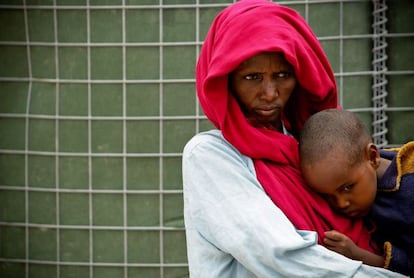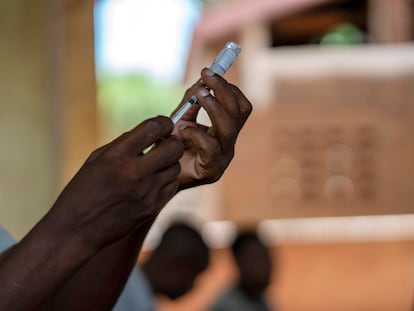New malaria vaccine has potential to save thousands of children in Africa
Experts believe it is a major leap forward in the fight against malaria, although it is not a silver bullet to end the disease

Every year, 25 million children are born in African countries where malaria is endemic. Of them, half a million die annually from the disease transmitted by mosquitoes. In October 2021, a four-dose vaccine was approved that can reduce the symptomatic disease by 75%, but manufacturing it is slow, and the serum is currently limited to about 18 million annual injections. This allows only 4.5 million minors to complete the course of vaccinations. The World Health Organization (WHO) has this week recommended a second, cheaper drug with a similar effectiveness that can relieve this bottleneck so that vaccinations can reach the majority of African children who need them.
Developed by the University of Oxford, the new drug is called R21/Matrix-M and will be produced by the Serum Institute in India, the largest vaccine manufacturer in the world. In the summer of 2024, the first vials are expected to leave the factory, which has the capacity to produce 100 million doses per year and can be scaled to 200 million. The company’s CEO, Adar Poonawalla, believes that by the end of 2024 there will no longer be an “imbalance between demand and supply.”
Its main production advantages, explains Regina Rabinovich, director of the Malaria Elimination Initiative at the ISGlobal Health Institute, are that it uses an adjuvant (a substance that enhances the immune response) that is easier to obtain and requires less of the main active ingredient to get a very similar response to the first vaccine recommended by the WHO: Mosquirix, produced by GSK.
That will decrease its price. While GSK’s costs €6.90 ($7.26) per dose, the new one will cost between €2 and €4 ($2.10 and $4.20), approximately half as much, which also makes it more affordable to implement. It will be a huge leap in protection against the parasite Plasmodium falciparum, which is the most aggressive and widespread in Africa, causing 90% of deaths from malaria.
Experts hope that the new drug will help to continue to reduce the number of deaths from this disease, which had been falling in recent decades, but which rebounded in 2020 as a result of the Covid-19 pandemic. According to the latest data available, it was estimated in 2021 that there would be 247 million cases, and that 619,000 people would die from malaria worldwide. Although it is a reduction of 6,000 deaths compared to the previous year, the figure is considerably higher than the 568,000 estimated in 2019.
The new vaccine’s WHO recommendation will allow countries that need it to adopt it more quickly, and is “very good news,” in the words of Quique Bassat, ICREA researcher at ISGlobal and director of the Malaria and Neglected Parasitic Diseases program. “The two we have now do not compete with each other; they are complementary. And they have different adjuvants, so producing one does not interfere with the production of the other,” he points out. But neither this nor the first, which share a very similar mechanism of action, are “a silver bullet against the disease.”
The experts have been repeating this message since the results of both drugs were first observed. Although clinical cases were reduced by 75% in the trials, the figure falls to approximately 29% in serious cases. The studies did not quantify the potential reduction in mortality, but it is estimated that for every 200 children on the complete regimen, one death can be avoided. This will be seen in the real world when the vaccination program, which is largely implemented with funding from the international GAVI alliance, is at full capacity.
Regardless of this figure, Rabinovich points out that the reduction in symptomatic cases as a result of the vaccine will also reduce the care burden in highly compromised health systems, such as those of malaria-endemic African countries. “This will allow health workers to take better care of the children who develop the disease. There will be a direct and an indirect benefit with the roll-out of vaccines,” he explains to EL PAÍS.
In the two years since the first vaccine was approved, the results have not been visible in terms of a global reduction in cases and deaths. Just over half a dozen countries had access to the injections. “With four doses per child, pilot tests were still being carried out in those countries. With the new vaccine, not only will countries where malaria is highly endemic be able to use it, but also those who have a lower incidence of the disease, but in which it is also present,” the expert continues.
The new vaccine was first rolled out in Ghana in April this year. And there are 18 African countries that are already requesting doses through GAVI. The WHO hopes that with increased production beginning in the middle of next year, more states will sign up.
Dengue vaccine
This week, the WHO has also recommended the dengue vaccine developed by the Japanese pharmaceutical company, Takeda. The four-in-one vaccine TAK-003, based on a weakened version of the virus that causes dengue, will be recommended for children between six and 16 years of age in areas where the disease has become a major public health problem.
Also called Qdenga, it was approved last year in Europe and in Spain it has been administered since this spring in traveler vaccination centers to travelers headed to endemic areas. It has also been approved in the United Kingdom, Brazil, Argentina, Indonesia, and Thailand, among other countries. The WHO recommendation, both for this vaccine and for malaria, benefits countries that do not have such powerful regulatory agencies and rely on the organization’s guidelines to implement the use of these injections.
Dengue transmission is increasing worldwide. The Aedes mosquito, its transmission vector, is present in more and more regions as a result of global warming. It can live at altitudes high above sea level and increasingly higher latitudes, threatening populations in highlands, mountainous areas, and temperate climates that were previously protected from this type of epidemic. This summer, the WHO even warned European countries to prepare for possible dengue outbreaks stemming from heat waves that are being experienced with increasing intensity and duration.
Despite the recommendation announced on Monday, Hanna Nohynek, president of the group that advises the WHO on immunization issues, stressed that the vaccine is in principle recommended for types 1 and 2 (the most dangerous) of the dengue virus. However, it is not recommended for types 3 and 4, as there is still “uncertainty” about its effectiveness. According to EFE (the Spanish news agency), the expert stressed that the group she chairs “recommends that the vaccine be considered for introduction in areas with a serious incidence of dengue and high rate of transmission.” Regarding the age of immunization, countries should check at what age of childhood or adolescence there are more serious cases that require hospitalization, and proceed to immunize those who are one or two years younger.
Sign up for our weekly newsletter to get more English-language news coverage from EL PAÍS USA Edition
Tu suscripción se está usando en otro dispositivo
¿Quieres añadir otro usuario a tu suscripción?
Si continúas leyendo en este dispositivo, no se podrá leer en el otro.
FlechaTu suscripción se está usando en otro dispositivo y solo puedes acceder a EL PAÍS desde un dispositivo a la vez.
Si quieres compartir tu cuenta, cambia tu suscripción a la modalidad Premium, así podrás añadir otro usuario. Cada uno accederá con su propia cuenta de email, lo que os permitirá personalizar vuestra experiencia en EL PAÍS.
¿Tienes una suscripción de empresa? Accede aquí para contratar más cuentas.
En el caso de no saber quién está usando tu cuenta, te recomendamos cambiar tu contraseña aquí.
Si decides continuar compartiendo tu cuenta, este mensaje se mostrará en tu dispositivo y en el de la otra persona que está usando tu cuenta de forma indefinida, afectando a tu experiencia de lectura. Puedes consultar aquí los términos y condiciones de la suscripción digital.
More information

A new weapon against malaria
Archived In
Últimas noticias
Most viewed
- Oona Chaplin: ‘I told James Cameron that I was living in a treehouse and starting a permaculture project with a friend’
- Reinhard Genzel, Nobel laureate in physics: ‘One-minute videos will never give you the truth’
- Sinaloa Cartel war is taking its toll on Los Chapitos
- Why the price of coffee has skyrocketed: from Brazilian plantations to specialty coffee houses
- Silver prices are going crazy: This is what’s fueling the rally










































